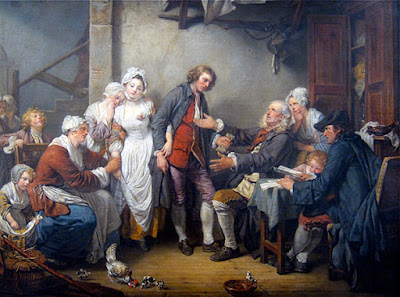 |
| Shortgown Front |
I finally finished a new shortgown/bedgown. It's about time. It's an easy pattern but finishing the edges by hand took forever. I find it really hard to get excited about "work clothes." Most notably because they get ripped up and dirty so quickly, especially while cooking. I'm sure only one trip to the hearth will have the kids asking "Why are you so dirty!?"
Shortgowns are unfitted or loosely fitted, work garments. Extant garments show that most were pinned shut but some have a few ties or even drawstrings at the neck and waist.
There had been a lot of debate among reenactors and historians about what a shortgown is versus a bedgown and whether or not these were considered appropriate public wear. Evidence points to these being casual or work wear. A 1793 version of the Shakespeare play Henry IV is annotated that "A half kirtle was perhaps the same kind of thing as we call at present a short gown or a bed gown," indicating that they were similar garments if not the same thing. Below are some great 18th century images of people wearing shortgowns outside or with visitors.
 |
| The Abusive Fruitwoman, 1773, Courtesy of the LOC. |
 |
| Jean-Baptiste Greuze, 1761 |
 |
| John Collet, 1764 |
 |
| Shortgown back |
18th Century Shortgown Sewing Pattern:
 |
| Right click and choose "open in new window" to see larger view. |
I folded the fabric horizontally and then again vertically so that I only had to cut the pattern out once. Good seamstresses will cringe. If you wish you can fold the fabric horizontally and trace the pattern a second time mirrored vertically.
Cut out the back neck hole first. Open up the fabric, then cut a vertical line down the center of the front. Adjust the neckline as you like, being sure to leave room for hemming. With right sides of the fabric together, sew under the arm and down the sides. Hem all loose ends. If you wish to have cuffs, fold the cuffs in half horizontally with right sides together. Fold 1/2 in up on the front and back of the cuff and sew the sides. Turn the cuff right side out and attach to sleeve. Fold the cuff up on the sleeve and secure it with a few stitches.
I ended up sewing a pleat under each arm as well as three in the back, all ending at the waist to make the garment a little more fitted. It's not necessary if you use an apron to give the fitted look or if you are a beginner and just want something easy to work on.
Other Patterns and Info:
- MaraRiley.net: Shortgowns
- Making The Manteau de Lit
If you are trying this and need help, don't hesitate to comment or email.



















